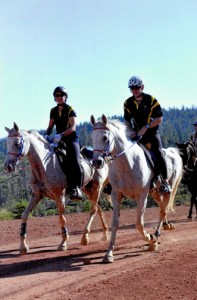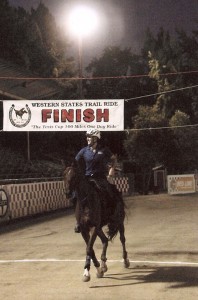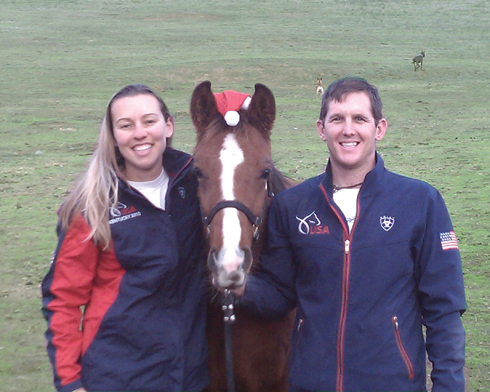Tevis topper Jeremy Reynolds on racing endurance
By Talmage Bachman December 1, 2011
Jeremy Reynolds and A Kutt Above race to the finish to win the NAETC Patriot's Day Ride as Meg Sleeper gives chase. (Photo by Gore Baylor)
Jeremy Reynolds is on a roll. In October he won both the Western States Trail Foundation’s Tevis Cup and Haggin Trophy, and in July he earned the prize for individual first place at the United States Equestrian Federation’s North American Endurance Team Challenge Patriot’s Day Race. At press time, he was tied for No. 1 on the USEF’s endurance rider ranking. His wife, Heather, sat at No. 13.
The Reynolds met in 2001 on what was Jeremy’s second endurance ride, the Fort Schellbourne XP. They were married a year later and launched Reynolds Racing, based in Los Gatos, CA. Winter finds them encamped just outside Ocala, Florida, where they arrived with five of their 11 horses and some clients in training. The Reynolds are somewhat unusual in the sport in that they actually earn their livelihood in endurance, training and selling horses and coaching riders. “We don’t make much, but we really enjoy what we do,” says Reynolds, 31.
They seem particularly well-attuned to balancing the interests of high-performance athleticism with the commercial realities of the sport. Reynolds chose to participate in Tevis over traveling to Chile to ride for the U.S. national team at the Pan American Endurance Championship (while neither offered a purse, Tevis was more geographically desirable and less costly to attend). Looking to 2012, however, their sights are set on the international circuit and riding at the CEIO level.
Along for the ride is 19-year-old Rachel Shackelford of Lincoln, CA, who came in second at Tevis riding tandem with Reynolds. She’s joined the couple in Florida specifically to gain experience in international competition, and plans to ride as a junior (16-21) for the USEF. “The governing bodies in our sport ― there is so much you have to know about in order to qualify to ride internationally. We help people through that process,” says Reynolds, who is also a farrier.
Following his win at Tevis, The Equestrian News contributor Tal Bachman asked him to share his views on this demanding sport, reaching him as the couple prepped for what they hoped would be a dual ride at the President’s Cup, held in the United Arab Emirates in February. “We have never raced it the same year,” notes Jeremy. “It’s an invitational, and we’ve never been selected together.” This time around, they’re feeling kind of lucky.
The Equestrian News: You have a remarkable record of success. How many times did you ride Tevis to get the three wins?
Jeremy Reynolds: Six times. There were three times I did not complete, but I won every time I completed.
TEN: If you can couch it this way, which was a bigger victory for you, the USEF championship or Tevis?
Reynolds: The North American championship actually, for us, is a much bigger deal. Tevis is more high-profile, but because it does not earn points with the USEF or FEI [Fédération Equestre Internationale] it is considered a more of a local race. The championships are more competitive. We go overseas sometimes for those races.
TEN: Where have you raced overseas?
Reynolds: Heather and I have raced or crewed for each other in Spain, Portugal, Malaysia and the UAE.
TEN: North American endurance riders rarely do well in European endurance races, why is that?
Reynolds: In Europe, they have more top competitions, and there is a very different atmosphere. In a European race there might be 100 entrants but 95 have a chance of winning. Here, out of 100, only five have a real chance of winning it. It’s only now that Americans are really stepping up.
TEN: How long have you been racing?
Reynolds: Ten years.
TEN: How did you get into it?
Reynolds: I was in college playing baseball, and my brother found a job for us training endurance horses. I already knew how to train horses, because [my best friend’s] mom had horses. I did jumping, gymkhana, pretty much everything. Then I just fell in love with the sport and stuck with it.
TEN: How crucial is your family to that track record of success?
Reynolds: My wife and I have a real partnership with Skip Lightfoot, and my brother is part of my crew. Between the four of us we get everything done. We’re the main stable, then we pick up extra friends to help sometimes. My mother comes to the big events and supports me, but she’s not a horse person. Pretty much the same with my wife’s parents, but they come and help as much as they can. Mostly it’s just the passion for horses between my wife and me and Skip, and my brother, who’s my identical twin.

Heather and Jeremy rode together at the NAETC championship in July. He won, and she and Destiny's Gold got pulled. (Gore Baylor Photography)
TEN: You seem to have left Heather in the dust during the Tevis ride.
Reynolds: I didn’t leave her in the dust exactly. Not true! We trained two horses for UAE riders, and Heather took them through the ride to make sure they would complete. We don’t really compete against each other during a race. We just take turns riding various horses, and it’s not really a competitive thing between us. She has a pretty stellar track record herself, having won Individual Gold at the 2001 Pan Ams and Individual Silver in 2003. Then she was part of the Team Gold at the 2005 North American Championship. She was the youngest rider ever to compete in endurance for the U.S. at the 2002 World Equestrian Games, when she was 24. She won Tevis in 2003.
TEN: How would you describe your overall strategy for winning?
Reynolds: I ride within what my horse is capable of. Heather and I have a talent for knowing exactly what’s underneath us, and we try to stay in their comfort zone. We don’t ride someone else’s pace – we just ride our horses. For example, in my last two big events, at times I was 10- to 15-minutes behind the frontrunner, and by the end, the other guy’s horses didn’t have anything left and I could keep on going.
TEN: Obviously at some point the decision was made to allow Rachel Shackelford to accompany you at Tevis.
Reynolds: At the race where Heather and I first met, that’s where we met Rachel and her family, so we’ve known her since she was like 8 years old. She rode with me and rode a smart race. But you know, if I hadn’t slowed down I could have beat her by a lot more (laughs).
TEN: She was on a 17-year-old horse!
Reynolds: At Tevis, my top competition, the one I was worried about the most, was Dennis Summers. So Rachel and I strategized together to get away from him. You try to open up a big enough gap so they can’t catch up. [Summers came in third, trailing by 52 minutes.]
TEN: Did you do anything unique to prepare Riverwatch, the horse you won with?
Reynolds: Well, I trained him specifically for the normal Tevis course [Editor’s Note: the Tevis Cup Ride, after being rescheduled from July to October, saw its course radically changed the night before the race due to weather] which is suited for mostly trotting. The course they actually ended up using was easier and we were able to canter more. I was worried because I hadn’t cantered much on him, and I was worried that would be a downfall, but obviously he ended up doing really well.
TEN: Was this year’s course was easier?
Reynolds: Yes.
TEN: So are you just going mostly at a steady pace?
Reynolds: We were moving along at between 10 and 15 miles per hour. The record is like a 15 miles per hour average.
TEN: Can you give us an outline of the conditioning regimen you use for your endurance horses?
Reynolds: That’s kind of a trade secret. I actually have people who pay me to set up training sessions, so I can’t really put that out there.
TEN: How do you gauge when the training is starting to wear down the horse, versus force the desired adaptive response?
Reynolds: It’s a total feel thing. I think we’re talented in that. We’re really in tune with the horse and its behavior. Some horses have a tendency to be lazy, others are hot and ready to go. Some don’t climb well, some have trouble breathing, so it’s how hard you push them.

Jeremy Reynolds and Riverwatch ride through misty mountains the morning of the 2011 Tevis Cup. (Photo by Gore Baylor)
TEN: What are the most crucial criteria in assessing whether a horse has potential as an endurance racer?
Reynolds: They have to be Arabian. There are a lot of arguments about it, but the truth is, it needs to be a full Arab. I also like horses that are happy doing it. I’ve had some horses that didn’t really like it, even though they’re bred for it and they can do the job. In terms of conformation, I’d say one crucial thing is that the forearm should be two times longer than the cannon bone. But I’ve also had some horses that looked like they’d be terrible but were great racers.
TEN: Can Akhal Tekes or Barbs or any
other breed be competitive with Arabs?
Reynolds: No. You can have Arabs crossed with other things sometimes, but then you’re not sure what you’re going to get, and you’re kind of just watering down the breed.
TEN: National Show Horses seem to have a bit of popularity.
Reynolds: Saddlebred/Arab crosses we say are “all show and no go.” Maybe you can do 50s [50-mile races] on them, but after 50 miles a lot of them break down. A lot of breeds can do endurance, but they tend not to be able to maintain the speed, and they tend to break down.
TEN: Some endurance breeders insist that the rider’s weight should never exceed 20% of the horse’s weight. Other breeders say that’s nonsense. Where do you come down on that question?
Reynolds: One of the reasons the U.S. Cavalry started importing Arabians is because they could carry so much weight. I’ve never heard of the 20% thing, but it’s definitely an advantage to be lighter, even though Arabs can carry much more weight percentage-wise than other breeds. We’ve noticed that even 10 pounds can make a huge performance difference. More weight also changes the horse’s stride a lot. It’s just physics.
TEN: What would you say the typical endurance racing horse’s best years are for racing?
Reynolds: I think they’re best around eight years old until around 16. Right around 12 they’re at their peak. After that, you’re on that verge of starting to have wear and tear factors, but they’re still the strongest around that age.
TEN: What kind of saddle do you use?
Reynolds: I use a variety of saddles depending on the horse. I’ve actually built a saddle that I use a lot. I use a treeless saddle about half the time, which works as long as you have a good saddle pad. Big Horns usually always fit. I have a new one from South America that’s super light called a Pampa.
TEN: And you keep your horses barefoot?
Reynolds: Yes. For racing, we use the Easyboot Glue-On shoes, though sometimes if the trail is really harsh, I’ll use a traditional shoe. Between races they’re barefoot, and they’re trimmed every two to three weeks.
TEN: How long does it take you to condition a horse for a 100 mile endurance race?
Reynolds: We buy horses from the track so they have a base, so within one season they’re ripping down the trails. If you get one who hasn’t been conditioned already it’ll take a few seasons.
TEN: Have you noticed any changes in endurance lately as a sport?
Reynolds: At the [FEI] level, definitely. The speeds are a lot faster. The trot is almost a useless gait. We canter most of the international races. That’s a big change.
TEN: Do you breed, and if so, what kind of foundation stock do you have?
Reynolds: We just bred our first horse, because I had a mare I was retiring, and we had a stallion in training that we really liked. But I’m not a breeder. We work a lot with Asgard Arabians, and Len Ashby and Helen Shelly are trainers that I get a lot of horses from. They breed for the race track. I get 90% of my horses from them.
TEN: Did you choose not to try to qualify for the Pan Am Games?
Reynolds: I was qualified, I just didn’t put my name in [for the trip]. I would have had to pay a lot for that. The USEF just puts up a little bit of money, but just the flights alone for the trip would have cost $18,000 [for us and two horses].
TEN: What’s your advice for newcomers?
Reynolds: If you call the AERC (American Endurance Riding Conference) they can hook you up with local racers to mentor you. But the most important thing is time with your animal. There are so many people that go to race, and they hurt their horses because they haven’t put in the time training.
TEN: The Western States Trail Foundation people seem reluctant to call Tevis a “race.” They call it the Tevis Cup Trail Ride. Is it a race to you?
Reynolds: Yeah, it’s a race. It’s funny that they say that, because it was designed as a race originally. It was two gentlemen arguing over what type of horse would be better suited for racing. One guy, Wendell Robie, had an Arab, another guy had a Thoroughbred. Robie said his Arab could beat anyone. There was even a $500 purse. There is a split right now that’s happening between our governing bodies, the FEI and AERC. The AERC has a lot of influence from the older crowds who say endurance is just a ride. The FEI is a lot more competitive. Some have concerns about how humane endurance racing is, but to me, putting the horse on the trail for three or four hours without eating and having the vet checks is arguably tougher on the horse than just going fast. No one’s shown that just going fast is harder on the horse.
For information about endurance racing, visit the American Endurance Ride Conference at wwwaerc.org.
Short URL: https://theequestriannews.com/?p=6838




